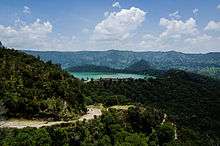Wonchi
Wanchi, also sometimes erroneously spelt as "Wonchi", is one of the woredas in the Oromia Region of Ethiopia. It is located in the South Western Shawa Zone; bordered on the southwest by Amaya, on the north by Western Shawa Zone, and on the southeast by Waliso and Goro District. The administrative centre of Wanchi is Chitu. Dariyan and Haro have emerged as rapidly growing rural towns.
The highest point in Wanchi is Ya'ii Chaboo peak, which is about 3,365 metres (11,040 ft) above sea level. Warqee (also known as Enset) is by far the most important staple crop in the area.

Wanchi lake is a crater lake located about equal distance between the town of Ambo and Woliso, at an altitude of about 3000m above sea level. Wonchi contains hot springs, waterfalls, valleys, and other scenery. In the island, an old monastery named Cherkos is found. Due to its unique topography, Wanchi is blessed with varieties of animal and plant species. For these reasons, Wanchi has been a very popular tourist destination in Ethiopia. This has been the case even when there was no dry weather road. Since the construction of Ambo-Waliso gravel road, tourism has emerged as one of the rapidly growing economic sectors in the district, Wanchi lake becoming a favored weekend destination for residents of nearby cities including Addis Ababa.
There are two islands in the lake. In one of the islands there is an ancient church called Cherkos monastery. You can navigate to the monasteries on ferries. The tourist can hire horses to take down the mountain to the lake. It takes about one hour from the top view to reach the lake side.
Demographics
The 2007 national census reported a total population for this woreda of 93,624, of whom 46,915 were men and 46,709 were women; 1,905 or 2.04% of its population were urban dwellers. The majority of the inhabitants said they practised Ethiopian Orthodox Christianity, with 70.12% of the population reporting they observed this belief, while 28.41% of the population were Protestant, and 1.28% were Muslim.[1]
Based on figures published by the Central Statistical Agency in 2005, this woreda has an estimated total population of 108,550, of whom 55,090 are men and 53,460 are women; 1,574 or 1.45% of its population are urban dwellers, which is less than the Zone average of 12.3%. With an estimated area of 457.51 square kilometers, Wonchi has an estimated population density of 237.3 people per square kilometer, which is greater than the Zone average of 152.8.[2]
The 1994 national census reported a total population for this woreda of 78,736, of whom 39,009 were men and 39,727 women; 880 or 1.12% of its population were urban dwellers at the time. The two largest ethnic groups reported in Wonchi were the Oromo (98.87%), and the Amhara (0.84%); all other ethnic groups made up 0.29% of the population. Oromiffa was spoken as a first language by 99.46%. The majority of the inhabitants professed Ethiopian Orthodox Christianity, with 93.18% of the population reporting they practiced that belief, while 5.23% of the population said they were Protestant, and 1.1% were Muslim.[3]
Notes
- ↑ 2007 Population and Housing Census of Ethiopia: Results for Oromia Region, Vol. 1, Tables 2.1, 2.5, 3.4 (accessed 13 January 2012)
- ↑ CSA 2005 National Statistics, Tables B.3 and B.4
- ↑ 1994 Population and Housing Census of Ethiopia: Results for Oromia Region, Vol. 1, part 1, Tables 2.1, 2.13, 2.16, 2.20 (accessed 6 April 2009)
Coordinates: 8°40′N 37°55′E / 8.667°N 37.917°E